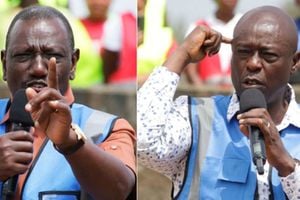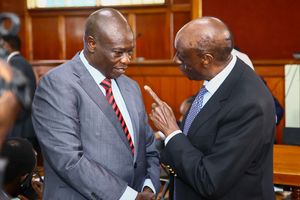
Patrice Motsepe, president of the African Confederation of Football (CAF), announces the host countries for the 2027 Africa Cup of Nations during a ceremony held in Cairo on September 27, 2023.
| Khaled Desouki |AFPFootball
Premium
What it will take to deliver 24-nation Africa Cup of Nations
What you need to know:
- It is estimated that the three east African countries will need to spend at least Sh14.8bn in preparations
In Kampala
The Confederation of Africa president Patrice Motsepe announced on Wednesday that the East African nations of Kenya, Uganda and Tanzania won the rights to host the 2027 Africa Cup of Nations.
This was after the now-famed ‘Pamoja Bid’ beat Egypt, Botswana and a joint submission by Nigeria and Benin.
To achieve this, the movers of the bid, mainly Fufa president Moses Magogo and his team, submitted a thoroughly organized book that was largely premised on the hope that the three governments will come through on all their promises.
Magogo had earlier in 2017 promised to bid for the 2025 edition that had been awarded to Guinea before being stripped off in October last year due to a slow pace in putting up the required infrastructure.
This (stripping of), the CAF President warned that could be repeated, after awarding the rights to the East African countries.
“We’re very strict in terms of the requirements that we are placing on these countries both in terms of freedom of movement of people in and out of the countries and the infrastructure,” Motsepe warned.
He reassured that the confederation will do continuous evaluations and assessment to determine the progress of the preparations.
First of all, governments had to submit written assurances that the tournament would be held successfully without any glitches.
Normally, for tournaments of such magnitude, the governments have to compromise their normal protocol. The letters comprised a memorandum signed by the cabinet that had specific commitments from the line ministries that touch on several issues, including sports, security, health, transport, and finance, foreign and internal affairs, among others.
For example, the three governments must’ve committed to the free flow of CAF executive members, staff, teams and fans without any issues and assure their safety during the entire period of stay. They must also relax some financial controls to allow the different stakeholders to carry unspecified amounts of money without trouble. The heads of state personally signed those documents.
A bid without the government commitment is dead on arrival.
First-class facilities
With the new 24-team format comes more costs. Every host city is expected to have a five-star rated hotel for the CAF members and staff and at least a four-star hotel for the teams.
Up to four teams can share a hotel, provided all the set requirements are met. A minimum of six stadiums are required and 12 training grounds, two near each stadium.
An airport facility in the main city and additional facilities in host cities that are about 200km away from the capital. The country is required to provide a good transport network between the stadiums, training grounds and the hotels. The country is also required to provide police security for all the officials, teams and CAF guests.
The main stadium for the opening and closing ceremonies should be at least a 50, 000-seater with installed seats, one of 40,000 that will host one semi-final and four others of at least 20,000 sitting capacity.
In the region, currently only one stadium meets all the standards as stipulated by CAF in case a member is to host the Africa Cup of Nations. That is the 60,000-seater Benjamin Mkapa Stadium in Dar Es Salaam.
Tanzania submitted the Mkapa Stadium in Dar Es Salaam and the Amani Stadium in Zanzibar and has promised to construct another with a capacity of 30,000 in Arusha as well as upgrade seven others.
Uganda promised to build two more in Hoima and Lira City on top of Namboole (45,000-seater).
Kenya is already renovating Moi International Sports Centre Kasarani (60,000-seater), Nyayo Stadium (30,000-seater) and Kipchoge Keino Stadium in Eldoret.
The stadium must be an international class in that they have a smooth playing surface with good drainage, well-separated media tribunes and a mixed zone with fully functional internet services, anti-doping rooms, four changing rooms, transport infrastructure and a working lighting system for high-definition video production.
Currently, Uganda has no stadium that meets the minimum required standards.
The respective government must commit to facilitating all the costs. It was reported that Rwanda spent over $21 million to get facilities ready for the 2016 Africa Nations Championship, the second-grade tournament to Afcon.
For Cameroon, the last host, Africa Business reported that the government sunk over $885 million for the tournament.
About $280 million went into constructing the Olembe stadium that hosted the final.
It is estimated that the Cameroon could’ve realized something between $150 to $200 million in revenue from the month-long showpiece.
An insider from the bidding team revealed to NMG that the preparations are expected to cost slightly in excess of $100m (about Sh14.8 billion).




